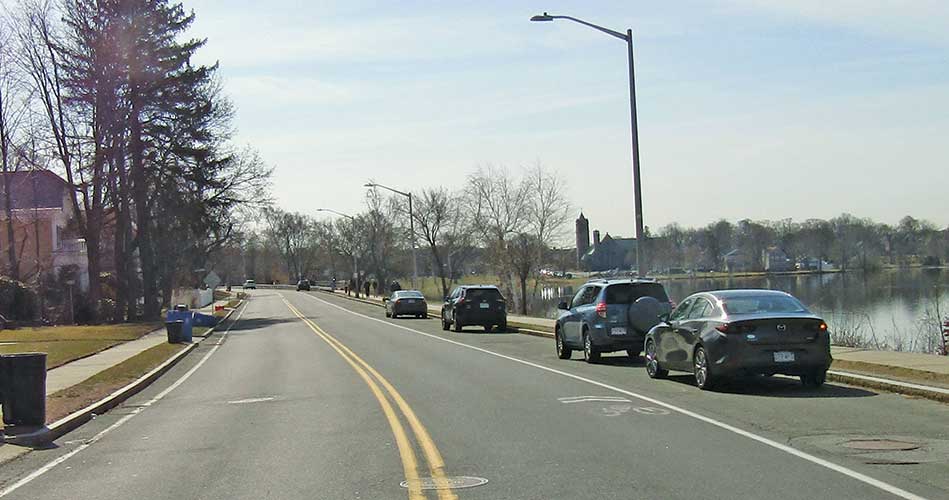
CHANGES to the Main Street right-of-way along the Lake were among of the more contentious aspects of the Wakefield Bicycle and Pedestrian Plan, which was passed this week by the Town Council in a 5-2 vote. (Mark Sardella Photo)
By MARK SARDELLA
WAKEFIELD — The Town Council this week approved the final version of the Wakefield Bicycle and Pedestrian Master Plan, although the vote was not unanimous. Councilors Michael McLane and Edward Dombroski, who have been critical of aspects of the plan, were the dissenters in the 5-2 vote to approve.
Town Engineer Bill Renault and Economic Development Director Erin Kokinda were once again in front of the board to present the latest updates to the plan since their last appearance on Feb. 26.
Kokinda began by reminding the board that the goals of the plan are to encourage walking, bicycling and rolling to key destinations throughout town, establish a plan that connects to surrounding communities and advance the Town’s Complete Streets Policy.
Renault reviewed the changes that had been made to the plan based on comments from Town Councilors at the Feb. 26 meeting. Those changes mainly addressed comments made by Councilors McLane and Dombroski related to the shared use path, right-of-way width, drive lanes and parking aisle width on Main Street along the Lake. Renault displayed cross sections of the right-of-way to illustrate the changes.
Renault also reviewed the feedback on the Bike/Ped Plan that had been received during the recent public comment period. Of the 89 total comments, 39 supported the plan, 19 were opposed and 31 were described as “indifferent.” Thirty-Four of the respondents also offered suggestions for modifications to the plan, Renault said.
Renault also outlined the next steps if the Town Council approved the plan, including finalizing any further changes and posting the final plan on the town’s web site. He recommended a periodic review of the plan every five years.
Town Council Chairman Jonathan Chines thanked Renault and Kokinda for their work, calling the Bicycle and Pedestrian Master Plan “a good product.”
But Town Councilor Michael McLane disputed Renault’s analysis of the public comments, saying that after reading every comment he came up with 30 in favor and 29 opposed. He added that the sample was not statistically valid anyway so it didn’t really matter.
McLane again raised questions about the width of the right-of-way on Main Street along the Lake and wanted assurances that the shared-use path would always be 10 feet wide.
He expressed concern that if anything went awry with the 55-foot right of way the shared-use path, which would serve the greatest number of people, would be shrunk.
Renault offered assurances that he would come back to the board if that happened.
McLane said that he was not against safety and would support protected bike lanes on any streets where that make sense. But he insisted that on a lot of streets it doesn’t make sense.
He also said that he didn’t want future Town Councils to feel that their hands were tied just because the Bicycle and Pedestrian Master Plan was approved in 2024.
Town Councilor Edward Dombroski noted that there has long been a push for wider sidewalks along the Lake. He said that the best use of available space was not being achieved in order to accommodate a bake lane that will get far less use than the sidewalk/shared-use path. He favored a 12-foot wide sidewalk as opposed to the 10-foot one in the plan.
Dombroski called the plan “overreach,” noting that few people bike or “roll” anywhere. He called reducing the width of driving lanes to accommodate bike lanes “a safety issue.”
He maintained that the plan dedicates more space than warranted to a smaller population of users (cyclists) at the expense of a much larger population of walkers and drivers.
He also warned that “Master Plans” have a way of establishing precedent and justification for future policy decisions. He maintained that the Bicycle and Pedestrian Master Plan as written does not do the most good for the most people most of the time.
Councilor Robert Vincent offered an amendment to the plan that would require the Town Council to solicit and consider advice from Fire, Police and Public Works departments as well as the Traffic Advisory Committee prior to the approval of all projects delineated in the plan. Vincent’s amendment was adopted by a 5-2 vote, with Dombroski and McLane opposed, mirroring the vote on the overall plan.




